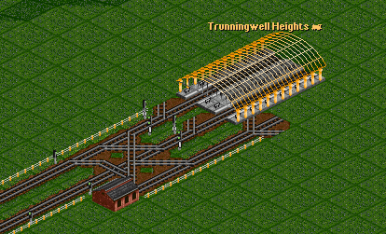Difference between revisions of "Overflow"
From #openttdcoop wiki
(Started an article on overflows, based on V's ABR 8-To be expanded) |
m |
||
| (9 intermediate revisions by 5 users not shown) | |||
| Line 1: | Line 1: | ||
| + | {{update|everything}} | ||
| + | [[Image:Overflow example.png|right|thumb|386px|An example showing the simplest and most commonly used overflow]] | ||
| + | |||
Overflows are a sometimes-handy feature of our networks. When they are used, they can save us a lot of work. On the other hand they have (of course) their disadvantages. | Overflows are a sometimes-handy feature of our networks. When they are used, they can save us a lot of work. On the other hand they have (of course) their disadvantages. | ||
| Line 8: | Line 11: | ||
==Disadvantages== | ==Disadvantages== | ||
| − | + | Overflows need space and sometimes additional logic. If they are built without a reverser, their depot is visible, which can ruin refit or train replacement games, and lead to problems in other games. | |
| − | + | ||
| − | + | ||
| + | ==See also== | ||
| + | *[[Two-way end of line]] | ||
| + | |||
| + | |||
| + | Blog articles: | ||
| + | * [http://blog.openttdcoop.org/2010/04/26/advanced-building-revue-04-overflows/ Advanced Building Revue 04] | ||
| + | * [http://blog.openttdcoop.org/2010/11/07/advanced-building-revue-08-overflows-ii/ Advanced Building Revue 08] | ||
| + | * [http://blog.openttdcoop.org/2012/06/28/advanced-building-revue-12-overflows-iii/ Advanced Building Revue 12] | ||
| + | |||
| + | |||
| + | [[Category:Stations]] | ||
| + | [[Category:Basic networking]] | ||
Latest revision as of 20:25, 20 October 2016
| Parts of this article (those related to everything) may no longer be up to date. Please update this article to reflect recent events or newly available information, and remove this template when finished. Please see the talk page for more information. |
Overflows are a sometimes-handy feature of our networks. When they are used, they can save us a lot of work. On the other hand they have (of course) their disadvantages.
Purpose
Why do we build an overflow – our station tends to catch wave traffic and sometimes it just jams. The primal source of this are usually just jams on the network, making trains come in random intervals, randomizing also their required count to take all the cargo. So the first reaction on jammed station shouldn’t be to add an overflow, but unjam the network first. In some cases it is possible that the station gets trains just randomly even when our network isn’t jamming at all. The perfect examples are basically any conditional orders, where trains could jump to other orders, skipping/adding part of their journey, reaching random travel times.
Disadvantages
Overflows need space and sometimes additional logic. If they are built without a reverser, their depot is visible, which can ruin refit or train replacement games, and lead to problems in other games.
See also
Blog articles:
